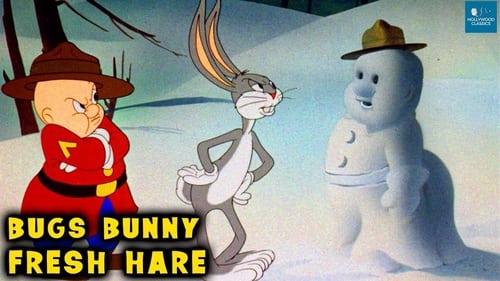Matialth
Good concept, poorly executed.
Listonixio
Fresh and Exciting
Fairaher
The film makes a home in your brain and the only cure is to see it again.
Murphy Howard
I enjoyed watching this film and would recommend other to give it a try , (as I am) but this movie, although enjoyable to watch due to the better than average acting fails to add anything new to its storyline that is all too familiar to these types of movies.
MartinHafer
"Fresh Hare" is one of several Warner Brothers cartoons that has been pulled from the market because of its racial insensitivities. While offensive, the company sure made worse (such as "Coal Black and de Sebben Dwarfs"--which would probably give the politically correct out there heart attacks if they see it). Now I am not excusing the ending--it was pretty offensive and I could see why the powers that be decided to yank this from the market.The cartoon finds Elmer Fudd as a Mountie out to get his man....I mean, rabbit. It seems that the screwy rabbit has crossed the line too many times and he's wanted by the authorities. What follows is generally quite funny and is well animated. However, completely out of left field comes a final weird and not very funny joke--one that leads to Bugs, Elmer and the rest of the Mounties putting on an impromptu minstrel show. Overall, much of the cartoon is cute and enjoyable and the ending is just plain odd and rather offensive.
j-b-w-1
The much-discussed black-face ending is a non-sequitur, by its nature completely gratuitous. It is blurred out in a recent Digiview Public Domain version and an R - for Restricted? - appears in a box at the top left of the screen.Other versions are available without the censorship. Or used to be.Of its time and not a good gag but such meddling does not reflect well on the company. All it says to me is that these PD racketeers just want to market their wares to kiddies.I'd cite this title as fairly strong evidence that Bugs is a gay character. Maybe someone with a bad conscience will censor the kissing, the sexualized power-games and the give-away silhouette in the snow. But who is the lady in this relationship? We are left guessing.
mirosuionitsaki2
What a wonderful cartoon. Great for historians and children. Well, except the end. But any who, yeah. Bugs Bunny is under arrest on a lot of charges. In the end, he turns himself in after Elmer cries because he couldn't catch him and he's a disgrace to the regiment. Bugs Bunny turns himself in to make him feel better. In the end, when he is about to get shot and has to make one last wish, he takes off his blindfold and sings, "I Wish I Was In Dixie!". Everyone starts singing. Odd ending.Like I said before, I recommend this cartoon for historians and children. Or if you just like to watch old cartoons, or cartoons from your time, I recommend this too.Also, I just want to name my favorite part. When Bugs Bunny kisses Elmer and digs himself a hole again.
Chip_douglas
You know the quality is going to be above average when a cartoon starts with an big orchestral intro and a still picture to complement the titles. Bugs Bunny, looking slightly less cute than he would in later years (and still having to be content with his name under the titles) evades and tricks Elmer the Mountie at every turn. Back in these days Elmer was so overweight he had to wear a girdle. But if you look closely you can actually see him sweating off those pounds during the wild chase scenes.In the forties the Warner Studios were still competing with Disney to produce the best looking animation around. It is obvious a lot of thought and care went into the backgrounds and character animation. Yet they still could not compare to the competition. However when it came to gags the Merry Melodies were unbeatable. There are probably more jokes crammed into these 7 minutes than in any 7 Disney cartoons of the same era. Only the final scene involving a black and white minstrel show feels a bit awkward nowadays, for we like to forget that these totally incorrect programmes ever existed. In fact it was not until the late Sixties that this type of shows was banned, about the same time the Merry Melodies ended their run.
7 out of 10


